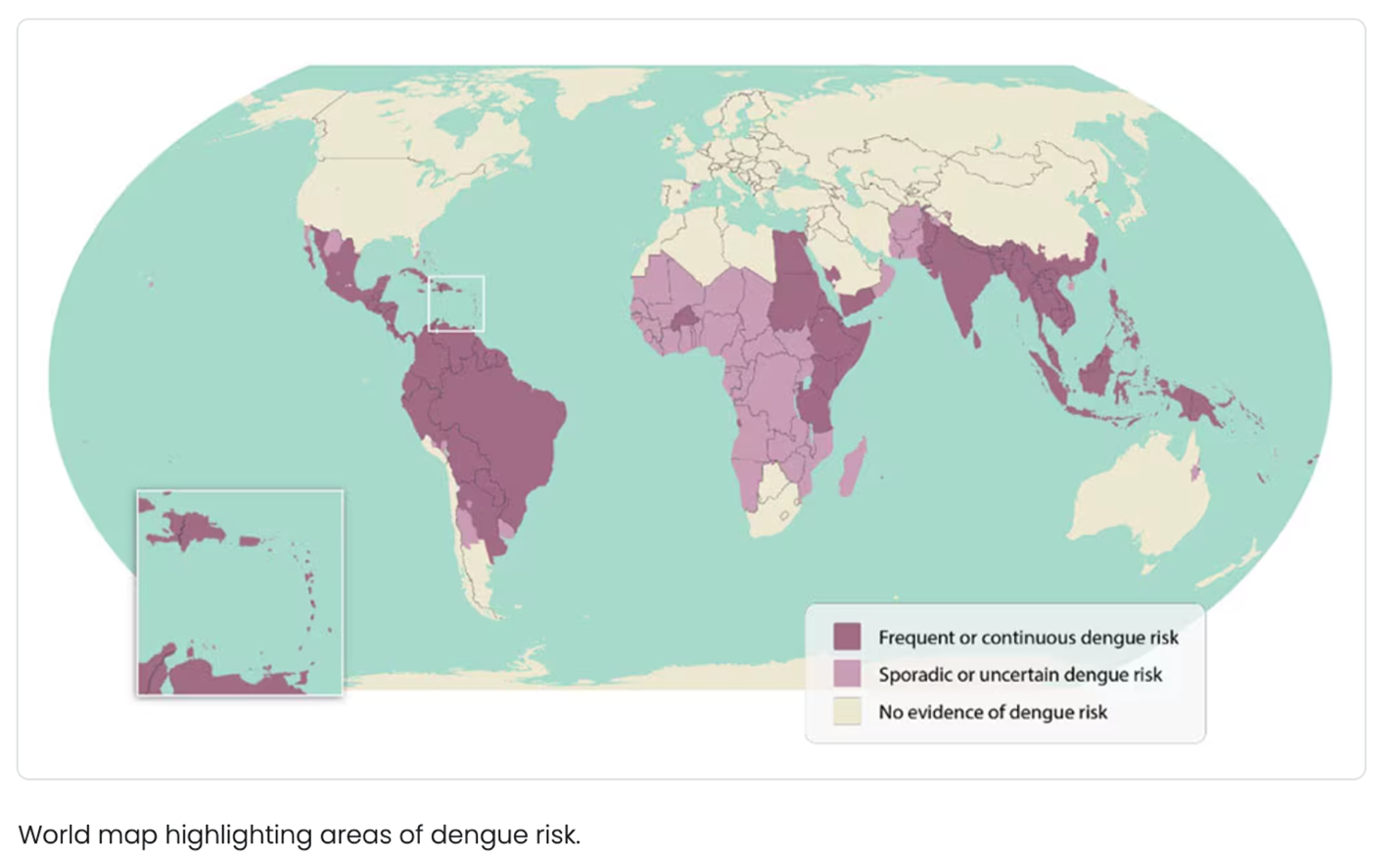Outbreaks, Alerts and Hot Topics: Dengue is Setting Records
Column Author & Editor: Chris Day, MD | Director, Transplant Infectious Disease Services; Medical Director, Travel Medicine Program
Worldwide, more dengue cases have been reported to date this year than were reported at this point in any prior year. There have been more dengue cases in the Western Hemisphere this year than in all of 2023.1 Dengue transmission increases in warm and wet conditions, and through May 2024 has been the warmest year on record.2 Eight cases of local transmission in Florida3 have been documented this year, with local outbreaks in Hawaii and Texas as well. In prior years cases of local transmission have been seen in Arizona and California. Puerto Rico has declared a public health emergency with around 1,500 cases this year.1
Dengue is a mosquito-borne infection caused by a group of four closely related flaviviruses: dengue (DENV-1, -2, -3 and -4). Immunity from infection with one strain typically leads to lifelong immunity to that strain, but contrary to usual expectations, prior infection can lead to more severe disease with a subsequent strain of dengue.1
Dengue infection should be suspected in anyone with a fever who has recently returned from an area where the virus is circulating between humans and mosquitoes (see Figure 1 and CDC.gov). Dengue is called break-bone fever based on the typical accompanying muscle, bone and joint pain. Pain behind the eyes, nausea, vomiting, and a transient macular or maculopapular rash are also common findings. The incubation period following a mosquito bite is usually around four to seven days with a range of three to 14 days. Severe dengue can be fatal. Indicators of severe disease include abdominal pain or tenderness, persistent vomiting, ascites or pleural effusion, mucosal bleeding, lethargy or restlessness, an increasing hematocrit, or liver enlargement. Infants < 1 year old are among those at greatest risk of severe disease.1,4
The best tool for diagnosis of dengue infection depends somewhat on when the patient comes to medical attention. In the first few days of illness, detection of the virus itself by either NS1 antigen testing or PCR of viral RNA will be superior. Later on, detection of the IgM immune response will be more helpful. It is generally recommended that both tests for viral detection and IgM titers are sent. Testing for other, similar illnesses, such as Chikungunya, is also recommended.
There is no specific treatment for dengue virus. Care for those ill with dengue infection is purely supportive. The CDC provides a pocket guide to help guide this care. Prevention includes avoidance of mosquitoes. The Aedes aegypti and Aedes albopictus mosquitoes that are the main carriers of dengue are predominantly daytime biters, but protection should be used continuously. During sleep, protection may mean an air-conditioned room or a permethrin-treated bed net. During waking hours, loose, permethrin-treated clothing plus an EPA-registered insect repellent is advised. I typically recommend DEET (35% concentration usually provides adequate duration) or picaridin.
A dengue vaccine, Dengvaxia, is indicated only for individuals who have already had dengue previously, as documented by serology. This vaccine can increase the risk of severe disease or hospitalization in people who have not previously had dengue. Unfortunately, due to a lack of demand, the manufacturer is discontinuing production of the vaccine formulation for children, which has been available for those ages 9-16. While no other dengue vaccine is currently available in the United States, two other vaccines are either approved or near approval in other countries and may be available in the future.
Figure 1: World map highlighting areas of dengue risk. Source: CDC.gov (link)

References:
- Center for Preparedness and Response. June 25, 2024. Increased risk of dengue virus infections in the United States. Centers for Disease Control and Prevention. https://emergency.cdc.gov/han/2024/han00511.asp
- In the grip of global heat. NASA Earth Observatory. June 25, 2024. https://earthobservatory.nasa.gov/images/152995/in-the-grip-of-global-heat
- Mosquito-borne disease surveillance. Florida Department of Health. July 2, 2024. https://www.floridahealth.gov/diseases-and-conditions/mosquito-borne-diseases/surveillance.html
- Symptoms of dengue and testing. Centers for Disease Control and Prevention. May 14, 2024. Accessed July 7, 2024. https://www.cdc.gov/dengue/signs-symptoms/index.html
